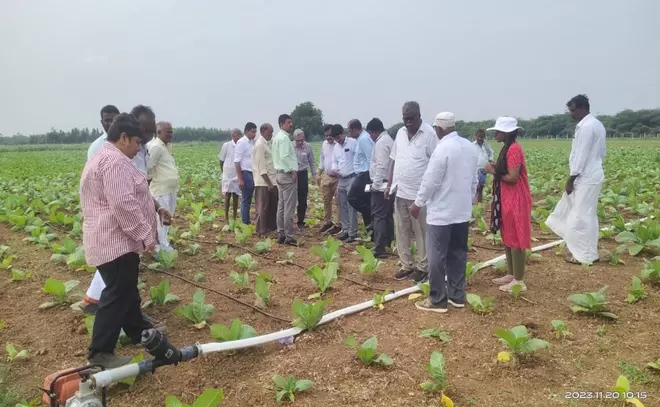

Drones are being used to supplement nutrition in the aftermath of the Mandous cyclone in Andhra Pradesh in 2022
That climate change is adversely impacting agriculture is no news. But a little-known fact is that it is causing extensive damage to the tobacco crop in India — causing an estimated loss of ₹800-900 crore in export revenues. “Because of the biotic and abiotic stresses caused by the vagaries of climate, the farmers are losing out on the output,” H N Ramaprasad, the Chief Executive of ITC’s tobacco business, told businessline.
He cites the example of tobacco farmers in Karnataka whose output fell to about 60 million kg (mkg) against the 90-100-mkg limit set by the Tobacco Board in 2021 and 2022.
For starters, the Board, an arm of the Union Commerce Ministry, regulates the tobacco crop size. After discussing with the stakeholders, it comes out with an annual crop size. The farmers can’t grow more than this.

Drip irrigation deployed to save tobacco crop from drought conditions
India exported an aggregate 2.19 lakh tonnes of tobacco and tobacco worth ₹6,529.30 crore in 2021-22. ITC has a share of 35 per cent in the country’s exports.
“We have noticed that climate change is resulting in floods and droughts, which are adversely impacting the crop at different stages. Be it El-Nino or La Nina, farmers are losing out due to the volatile weather conditions such as floods and droughts,” he said.
“In order to help farmers mitigate the problem, we have devised a structured programme in 2021 and tied up with four companies to collect data to accurately forecast the weather conditions over the next few weeks,” Ramprasad said. “We gather the information from our partners such as Microsoft and SkyMet and collate them into easily understandable and actionable insights, before disseminating the same through WhatsApp groups and through Zoom calls,” he said.
Since it is a regulated crop, the number of farmers is finite, allowing the company to reach out to those in the vulnerable areas. The firm has chosen the coastal areas of Nellore and Prakasam districts, which are vulnerable to extreme events, in Andhra Pradesh. After piloting the elements of the tool kit that it devices in over 70,000 hectares in these two districts, the company has extended it to tobacco-growing areas in Mysore, which produce export-oriented tobacco.
“We have added 70,000 hectares more in Karnataka under the climate mitigation programme, taking the total area under the programme at 1.40 lakh hectares,” he said.
The occurrence of two seasons of drought followed by equal number of wet weather seasons brought down the production of Indian traditional flue-cured crop to sub-optimal levels of 74-87 mkg from a potential of more than 120 mkg. “The tobacco grown in Mysore area is export-oriented, with 75 per cent of the output from here is being exported. The hostile weather impacted crop size and quality,” he said.
The programme was devised to make tobacco crop climate-resilient and ensure farmers don’t miss out on the export opportunity.
Besides sending the weather forecasts, the company would also suggest farmers what to do in times of a flood or prolonged dry weather. “This makes the farmer ready and reduces the damages,” he said. He cited the example of the cyclone Mandous in 2022, where he claimed the intervention helped the farmers reduce damages to just 4-5 per cent as against the estimated losses of 40 per cent.
The programme involves a forecast-based crop advisory, rain/drought hotspot mapping, drones, weather-based growing models and extensive use of analytical tools such as AI and Data Analytics.
Going forward, the company would focus on varietal development to help the crops face biotic and abiotic stresses.
Published on January 1, 2024

Comments
Comments have to be in English, and in full sentences. They cannot be abusive or personal. Please abide by our community guidelines for posting your comments.
We have migrated to a new commenting platform. If you are already a registered user of TheHindu Businessline and logged in, you may continue to engage with our articles. If you do not have an account please register and login to post comments. Users can access their older comments by logging into their accounts on Vuukle.